业余无线电中继46页PPT
- 格式:ppt
- 大小:4.07 MB
- 文档页数:46
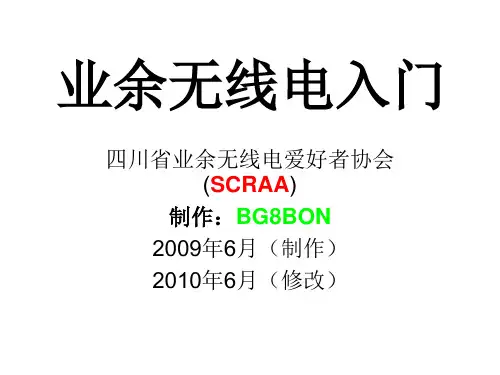
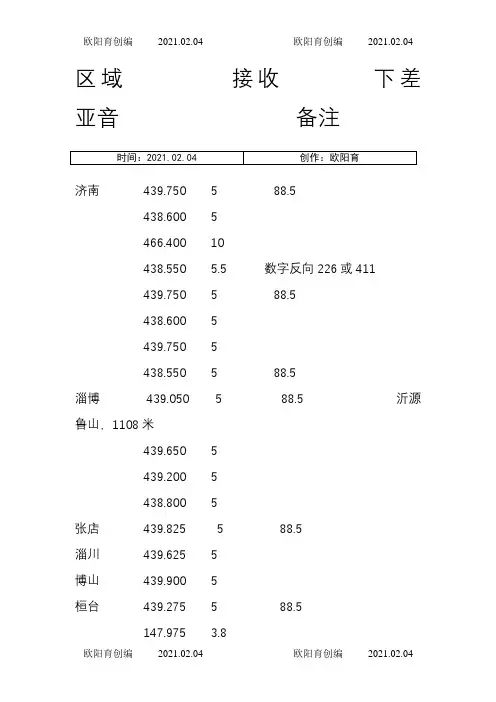
区域接收下差亚音备注济南439.750 5 88.5438.600 5466.400 10438.550 5.5 数字反向226或411439.750 5 88.5438.600 5439.750 5438.550 5 88.5淄博439.050 5 88.5 沂源鲁山,1108米439.650 5439.200 5438.800 5张店439.825 5 88.5淄川439.625 5博山439.900 5桓台439.275 5 88.5147.975 3.8泰安147.900 3.8 泰山,1532米439.850 5 88.5 泰山,1532米438.675 5 88.5438.650 5 88.5 499米438.525 5 88.5145.500 0.6439.750 5439.175 5 88.5 徂徕山,1027米新泰439.750 5439.650 5德州439.700 7 94.8临盘439.475 5邹平438.850 5438.650 5齐河439.900 5 88.5潍坊439.250 5439.150 5临朐439.650 5439.675 5 沂山,1031米439.625 5昌邑439.200 5滨海439.300 5 88.5青州438.550 5 88.5 检修439.000 5 代用145.300 0.6439.575 5寿光439.350 5 88.5昌乐439.550 5青岛438.800 7 88.5 自驾438.700 5 88.5 BR4IA438.750 5438.550 5 88.5 BY4LQD439.900 7 88.5城阳439.175 6.5 88.5438.175 5 88.5 应急439.725 5 88.5即墨439.025 5 88.5 120米崂山438.885 5 88.5黄岛439.150 5 88.5胶州438.450 5 88.5胶南439.675 5 88.5439.800 5 107.2147.825 3.8 88.5莱芜439.525 5 88.5439.375 5 88.5菏泽439.600 5 114.8东营438.700 5438.300 5438.900 5 88.5147.975 3.6439.300 5河口438.150 5 河口区枣庄439.350 5439.550 5 88.5147.9375 3.9山亭438.950 5 88.5滕州438.500 5 88.5438.600 5 88.5439.600 5 88.5438.300 5 77临沂439.750 5 88.5 BY4LY 137.5米145.750 0.6 88.5 BY4LY 蒙山,1109米439.300 8 74.4 临沂阳光户外运动俱乐部罗庄439.675 5 88.5郯城439.600 5 88.5147.900 3.8 88.5439.625 5 88.5烟台438.250 5 103.5147.900 3.8蓬莱439.375 9 88.5 测试中龙口439.075 5 110.9 东城区439.100 5 110.9 西城区莱阳438.625 5438.650 5招远438.900 5莱州438.200 5莱阳438.625 5 91.5日照439.100 7 88.5 浮来山莒县439.875 5 88.5147.950 3.8 88.5 浮来山济宁438.550 5 88.5438.500 5 88.5438.700 5 88.5147.925 3.8 88.5邹城439.900 5 88.5兖州439.975 5 88.5威海147.950 3.8文登147.900 3.8荣成147.975 3.8 88.5439.650 5 118.8 石岛,测试中滨州438.975 7 88.5邹平438.850 5468.650 5博兴439.000 5 88.5惠民439.150 5439.500 5聊城438.850 5 88.52010.12.30更新。
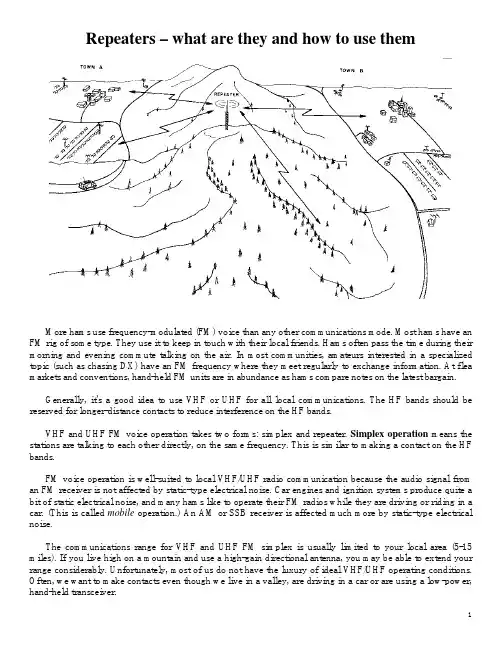
Repeaters – what are they and how to use themMore hams use frequency-modulated (FM) voice than any other communications mode. Most hams have an FM rig of some type. They use it to keep in touch with their local friends. Hams often pass the time during their morning and evening commute talking on the air. In most communities, amateurs interested in a specialized topic (such as chasing DX) have an FM frequency where they meet regularly to exchange information. At flea markets and conventions, hand-held FM units are in abundance as hams compare notes on the latest bargain.Generally, it's a good idea to use VHF or UHF for all local communications. The HF bands should be reserved for longer-distance contacts to reduce interference on the HF bands.VHF and UHF FM voice operation takes two forms: simplex and repeater. Simplex operation means the stations are talking to each other directly, on the same frequency. This is similar to making a contact on the HF bands.FM voice operation is well-suited to local VHF/UHF radio communication because the audio signal from an FM receiver is not affected by static-type electrical noise. Car engines and ignition systems produce quite a bit of static electrical noise, and many hams like to operate their FM radios while they are driving or riding in a car. (This is called mobile operation.) An AM or SSB receiver is affected much more by static-type electrical noise.The communications range for VHF and UHF FM simplex is usually limited to your local area (5-15 miles). If you live high on a mountain and use a high-gain directional antenna, you may be able to extend your range considerably. Unfortunately, most of us do not have the luxury of ideal VHF/UHF operating conditions. Often, we want to make contacts even though we live in a valley, are driving in a car or are using a low-power, hand-held transceiver.Enter repeaters. A repeater receives a signal and re-transmits it, usually with higher power and from a better location, to provide a greater communications range. Often located atop a tall building or high mountain, VHF and UHF repeaters greatly extend the operating range of amateurs using mobile and hand-held transceivers. If a repeater serves an area, it's not necessary for everyone to live on a hilltop. You only have to be able to hear the repeater's transmitter and reach the repeater's receiver with your transmitted signal.A repeater receives a signal on one frequency and simultaneously retransmits (repeats) it on another frequency. The frequency it receives on is called the input frequency, and the frequency it transmits on is called the output frequency.To use a repeater, you must have a transceiver that can transmit on the repeater's input frequency and receive on the repeater's output frequency. The input and output frequencies are separated by a predetermined amount that is different for each band. This separation is called the offset. For example, the offset on 1.25 meters is 1.6 MHz. A repeater on 1.25 meters might have its input frequency on 222.32 MHz and its output on 223.92 MHz. Repeater frequencies are often specified in terms of the output frequency (the frequency you set your receiver to listen on) and the offset. Your transmitter operates on a frequency that is different from the receive frequency by the offset amount.Most transceivers designed for FM repeater operation are set up for the correct offset. They usually have a switch to change between simplex operation (transmit and receive on the same frequency) and duplex operation (transmit and receive on different frequencies). So, if you wanted to use the repeater in the preceding example, you would switch your transceiver to the duplex mode and dial up 223.92 to listen to the repeater. When you transmit, your rig will automatically switch to 222.32 MHz (1.6 MHz lower in frequency), the repeater input frequency.When you have the correct frequency dialed in, just key your microphone button to transmit through ("access") the repeater. Most repeaters are open -- that is, available for use by anyone in range. Some repeaters, however, have limited access. Their use is restricted to exclusive groups, such as members of a club. Such closed repeaters require the transmission of a continuous subaudible tone or a short "burst" of tones for access. These are called CTCSS (continuous tone-coded squelch system) or PL (Private Line PL is a Motorola trademark) tones. There are also some repeaters available for use by everyone that require the use of special codes or subaudible tones to gain access. The reason for requiring access tones for "open" repeaters is to prevent interference from extraneous transmissions that might accidentally key the repeater. If you wish to join a group that sponsors a closed repeater, contact the repeater control operator.Finding a RepeaterMost communities in the United States are served by repeaters. While the majority of repeaters (over 6000) are on 2 meters, there are more than 1600 repeaters on 222 MHz, more than 5000 on 440 MHz, over 70 on 902 MHz and more than 200 on 1270 MHz. More repeaters are being put into service all the time. Repeater frequencies are selected through consultation with frequency coordinators -- individuals or groups that recommend repeater frequencies based on potential interference and other factors.a comprehensive listing of repeaters throughout the activity, theCertain segments of each band are set aside for FM operation. For example, on 1.25 meters, repeater inputs are found between 222.32 and 223.28 MHz. The corresponding outputs are between 223.92 and 224.98 MHz.Frequencies between 223.42 and 223.9 MHz are set aside for simplex operation. On 23 cm, repeater inputs run between 1270 and 1276 MHz, with corresponding outputs between 1282 and 1288 MHz. Simplex operation is between 1294 and 1295 MHz.Repeater OperatingBefore you make your first FM repeater contact, you should learn some repeater operating techniques. It's worth a few minutes to listen and familiarize yourself with the procedures used by other hams in your area. Accepted procedures can vary slightly from repeater to repeater.Your First TransmissionMaking your first transmission on a repeater is as simple as signing your call. If the repeater is quiet, just say "N1GZO" or "N1GZO listening" -- to attract someone's attention. After you stop transmitting, you will usually hear the unmodulated repeater carrier for a second or two. This squelch tail lets you know that the repeater is working. Someone interested in talking to you will call you after your initial transmission. Some repeaters have specific rules for making yourself heard. In general, however, your call sign is all you need.Don't call CQ to initiate a conversation on a repeater. It takes longer to complete a CQ than to transmit your call sign. (In some areas, a solitary "CQ" is permissible.) Efficient communication is the goal. You are not on HF, trying to attract the attention of someone who is casually tuning across the band. In the FM mode, stations are either monitoring their favorite frequency or not. Except for scanner operation, there is not much tuning across the repeater bands.To join a conversation in progress, transmit your call sign during a break between transmissions. The station that transmits next will usually acknowledge you. Don't use the word "break" to join a conversation --unless you want to use the repeater to help in an emergency. To make a distress call over a repeater, say "break break" and then your call sign to alert all stations to stand by while you deal with the emergency.A further word about emergencies: Regardless of the band, mode or your class of license, FCC Rules specify that, in case of emergency, the normal rules can be suspended. If you hear an emergency call for help, you should do whatever you can to establish contact with the station needing assistance, and immediately pass the information on to the proper authorities. If you are talking with another station and you hear an emergency call for help, stop your QSO immediately and take the emergency call.To call another station when the repeater is not in use, just give both calls. For example, "N1II, this is N1BKE'' If the repeater is in use, but the conversation sounds like it is about to end, wait before calling another station. If the conversation sounds like it is going to continue for a while, however, transmit only your call sign between their transmissions. After you are acknowledged, ask to make a quick call. Usually, the other stations will stand by. Make your call short. If your friend responds, try to meet on another repeater or on a simplex frequency. Otherwise, ask your friend to stand by until the present conversation ends.Use plain language on a repeater. If you want to know someone's location, say "Where are you?" If you want to know whether someone you're talking with is using a mobile rig or a hand-held radio, just ask: "What kind of radio are you using?" You get the idea.Courtesy CountsIf you are in the midst of a conversation and another station transmits his or her call sign between transmissions, the next station in line to transmit should acknowledge the new station and permit the new arrival to make a call or join the conversation. It is impolite not to acknowledge new stations, or to acknowledge them but not let them speak. The calling station may need to use the repeater immediately. He or she may have an emergency to handle, so let him or her make a transmission promptly.A brief pause before you begin each transmission allows other stations to break in -- there could be an emergency. Don't key your microphone as soon as someone else releases theirs. If your exchanges are too quick, you can prevent other stations from getting in.The courtesy tones found on some repeaters prompt users to leave a space between transmissions. The beeper sounds a second or two after each transmission to permit new stations to transmit their call signs in the intervening time. The conversation may continue only after the beeper sounds. If a station is too quick and begins transmitting before the beeper sounds, the repeater may indicate the violation, sometimes by shutting down!Keep transmissions as short as possible, so more people can use the repeater. Again, long transmissions could prevent someone with an emergency from getting the chance to call for help through the repeater. All repeaters encourage short transmissions by "timing out" (shutting down for a few minutes) when someone gets longwinded. The time-out timer also prevents the repeater from transmitting continuously, due to distant signals or interference. Because it has such a wide coverage area, a continuously transmitting repeater could cause unnecessary interference. Continuous operation can also damage the repeater.You must transmit your call sign at the end of a contact and at least every 10 minutes during the course of any communication. You do not have to transmit the call sign of the station to whom you are transmitting.Never transmit without identifying. For example, keying your microphone to turn on the repeater without saying your station call sign is illegal. If you do not want to engage in conversation, but simply want to check if you are able to access a particular repeater, simply say "N1KB testing."Fixed Stations and Prime TimeRepeaters were originally intended to enhance mobile communications. During commuter rush hours, mobile stations still have preference over fixed stations on some repeaters. During mobile prime time, fixed stations should generally yield to mobile stations. When you're operating as a fixed station, don't abandon the repeater completely, though. Monitor the mobiles: your assistance may be needed in an emergency. Use good judgment: Rush hours are not the time to test your radio extensively or to join a net that doesn't deal with the weather, highway conditions or other subjects related to commuting. Third-party communications nets probably should not be conducted on a repeater during prime commuting hours.Simplex OperationAfter you have made a contact on a repeater, move the conversation to a simplex frequency if possible. The repeater is not a soapbox. You may like to listen to yourself, but others, who may need to use the repeater, will not appreciate your tying up the repeater unnecessarily. The easiest way to determine if you are able to communicate with the other station on simplex is to listen to the repeater input frequency. Since this is the frequency the other station uses to transmit to the repeater, if you can hear his signals there, you should be ableto use simplex. If you want to perform an on-the-air test of a pair of hand-held radios, you should select an unoccupied simplex frequency.The function of a repeater is to provide communications between stations that can't otherwise communicate because of terrain, equipment limitations or both. It follows that stations able to communicate without a repeater should not use one. That way, the repeater is available for stations that need it. (Besides, communication on simplex offers a degree of privacy impossible to achieve on a repeater. On simplex you can usually have extensive conversations without interruption.)Select a frequency designated for FM simplex operation. Otherwise, you may interfere with stations operating in other modes without realizing it. (The reason for this is simple: Changing to a simplex frequency is far easier than changing the frequencies a repeater uses.) To see if you and the other station can communicate on a simplex frequency, listen on the repeater input frequency. If you can clearly hear what's going into the repeater, you don't need the repeater to communicate.Common VHF/UHF FM Simplex Frequencies2-Meter Band 146.52* 146.535 146.55146.565 146.58146.595 147.42147.435 147.45147.465 147.48147.495 147.51147.525 147.54147.555 147.57147.5851.25-Meter Band223.42223.44223.46223.48223.50*223.5270-cm Band446.0*33-cm Band906.5*23-cm Band1294.5*1294.0001294.025Every 25 kHz to 1295* National simplex frequencyAutopatch: Use it WiselyAn autopatch allows repeater users to make telephone calls through the repeater. To use most repeater autopatches, you generate the standard telephone company tones to access and dial through the system. The tones are usually generated with a telephone-type tone pad connected to the transceiver. Tone pads are available from equipment manufacturers as standard or optional equipment. They are often mounted on the front of a portable transceiver or on the back of a fixed or mobile transceiver's microphone. Whatever equipment you use, the same autopatch operating procedures apply.There are strict guidelines for autopatch use. The first question you should ask is "Is the call necessary?" If it is an emergency, there is no problem -- just do it! Calling for an ambulance or a tow truck is okay. Otherreasons may fall into a gray area. As a result, some repeater groups expressly forbid autopatch use, except for emergencies.Don't use an autopatch where regular telephone service is available. One example of poor operating practice can be heard most evenings in any metropolitan area. Someone will call home to announce departure from the office. Why not make that call from work before leaving?Never use the autopatch for anything that could be considered business communications. The FCC strictly forbids you to conduct communications in Amateur Radio for your business or for your employer. You may, however, use Amateur Radio to conduct your own personal communications. The rules no longer forbid you to use the autopatch to call your doctor or dentist to make an appointment, or to order food, for example.Don't use an autopatch just to avoid a toll call. Autopatch operation is a privilege granted by the FCC. Abuses of autopatch privileges may lead to their loss for everyone.You have a legitimate reason to use the autopatch? Here's how most systems operate. First, you must access (turn on) the autopatch, usually by pressing a designated key on the tone pad. Ask the other hams on a repeater how to learn the access code. Many clubs provide this information only to club members. When you hear a dial tone, you know that you have successfully accessed the autopatch.Now, simply punch in the telephone number you wish to call.Once a call is established, remember that you are still on the air. Unlike a normal telephone call, only one party at a time may speak. Both you and the other person should use the word "over" to indicate that you are finished talking and expect a reply. Keep the call short. Many repeaters shut off the autopatch after a certain time.Turning off the autopatch is similar to accessing it. A key or combination of keys must be punched to return the repeater to normal operation. Ask the repeater group sponsoring the autopatch for specific information about access and turn-off codes, as well as timer specifics. Don't forget to identify your station. Most groups expect you to give your call sign, the date and time just before accessing the autopatch and just after turning it off.。

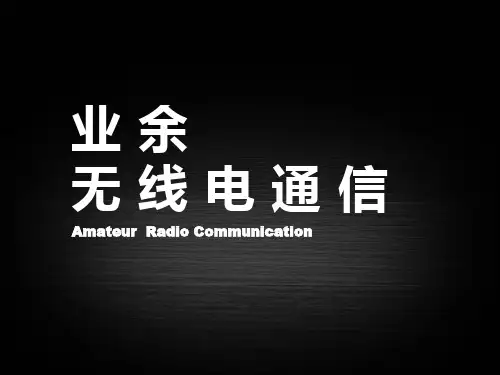

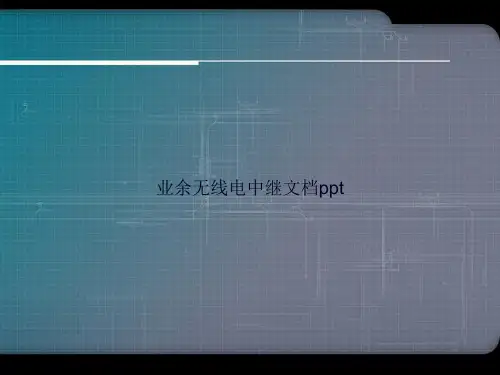
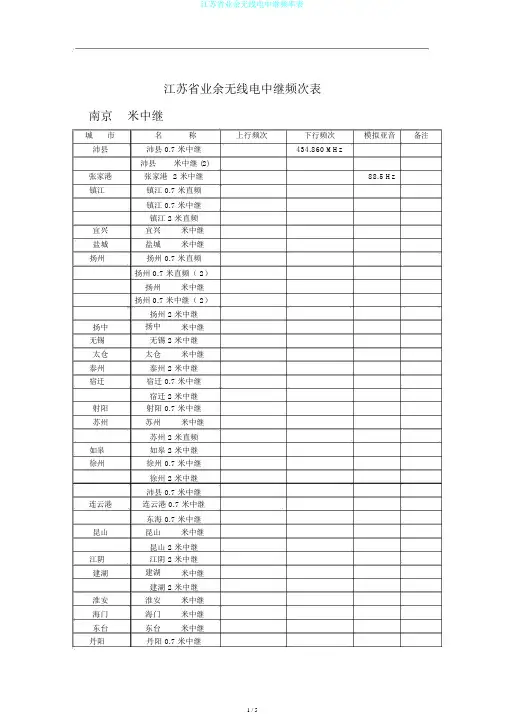
江苏省业余无线电中继频次表南京米中继城市名称上行频次下行频次模拟亚音备注沛县沛县 0.7 米中继434.860 MHz沛县米中继 (2)张家港张家港 2 米中继88.5 Hz镇江镇江 0.7 米直频镇江 0.7 米中继镇江 2 米直频宜兴宜兴米中继盐城盐城米中继扬州扬州 0.7 米直频扬州 0.7 米直频( 2)扬州米中继扬州 0.7 米中继( 2)扬州 2 米中继扬中扬中米中继无锡无锡 2 米中继太仓太仓米中继泰州泰州 2 米中继宿迁宿迁 0.7 米中继宿迁 2 米中继射阳射阳 0.7 米中继苏州苏州米中继苏州 2 米直频如皋如皋 2 米中继徐州徐州 0.7 米中继徐州 2 米中继沛县 0.7 米中继连云港连云港 0.7 米中继东海 0.7 米中继昆山昆山米中继昆山 2 米中继江阴江阴 2 米中继建湖建湖米中继建湖 2 米中继淮安淮安米中继海门海门米中继东台东台米中继丹阳丹阳 0.7 米中继丹阳 2 米直频大丰大丰 0.7 中继楚州楚州 2 米中继常州常州 0.7 米中继常州 2 米中继常熟常熟 0.7 米中继433.050 MHz宝应宝应 0.7 米中继宝应 2 米中继南通南通 0.7 米直频南通米直频( 2)南通 0.7 米中继南通 2 米中继泗洪泗洪 0.7 米中继MHz MHzMHz MHzMHz MHz安徽省中继频次表城市名称上行频次下行频次模拟亚音备注界首界首米中继淮北淮北 0.7 米中继淮南淮南 0.7 米中继黄山黄山米中继合肥合肥米中继合肥 0.7 米中继( 2)合肥 2 米中继颖上颍上 0.7 米中继430.175 MHz阜阳阜阳 0.7 米中继阜阳 2 米中继凤台凤台米中继滁州滁州米中继蚌埠蚌埠米中继蚌埠 2 米中继潘集米中继亳州亳州米中继亳州 2 米中继宿州宿州米中继泾县泾县米中继六安六安米中继MHz MHz HzMHz MHz HzMHz MHz HzMHz MHz Hz浙江省中继频次表城市名称上行频次下行频次模拟亚音备注杭州杭州 2 米中继88.5 Hz杭州 6 米中继嘉兴嘉兴米中继嘉兴 2 米中继海宁海宁 2 米中继海盐海盐米中继海盐米中继( 2)宁波宁波米中继宁波 2 米中继平湖平湖 0.7 米中继义乌义乌 0.7 中继义乌 2 米中继义乌 2 米直频永康永康 0.7 米直频余姚余姚米中继桐乡桐乡米中继温州温州 2 米中继绍兴绍兴米中继松阳松阳 2 米中继乐清乐清 2 米中继临安临安 0.7 米直频临安 2 米中继上海市中继频次表城市名称上行频次下行频次模拟亚音备注上海上海 0.7 米中继上海 0.7 米中继( 2)上海松江0.7 米中继上海崇明0.7 米中继上海 0.7 米直频上海 2 米直频MHz MHzMHz MHzMHz MHzMHz MHzMHz MHzMHz MHzMHz MHz山东省中继频次表城市名称上行频次下行频次模拟亚音备注济南济南米中继济南 0.7 米中继( 2)济南 0.7 米中继( 3)邹城邹城米中继淄博淄博 0.7 米中继淄博 0.7 米中继( 2)济宁济宁米中继济宁 2 米中继桓台桓台米中继桓台 2 米中继东营东营 0.7 米中继东营 0.7 米中继( 2)东营 0.7 米中继( 3)东营 2 米中继东营河口 0.7 米中继德州德州米中继昌邑昌邑 0.7 米中继滨州滨州邹平县0.7 米中继邹平县 0.7 米中继( 2)莒县莒县米中继莒县浮来 0.7 米中继莒县浮来 2 米中继枣庄枣庄 0.7 米中继枣庄 0.7 米中继( 2)烟台烟台 2 米中继威海威海 2 米中继潍坊潍坊 0.7 米中继潍坊临胊县0.7 米中继潍坊滨海 0.7 米中继秦城秦城 0.7 米中继434.850 MHz439.850 MHz泰安泰安 0.7 米中继泰安 2 米中继滕州滕州米中继88.5 Hz寿光寿光米中继新泰新泰 0.7 米中继新泰 0.7 米中继( 2)青岛青岛米中继青岛 2 米直频青岛 SH 俱乐部中继青岛城阳0.7 米中继城市名称上行频次下行频次模拟亚音备注青州青州 0.7 米中继青州 2 米直频青州 2 米中继莱阳莱阳 0.7 米中继莱芜 0.7 米中继龙口龙口 0.7 米中继临沂临沂米中继临沂 BY4LY 2 米中继临沂阳光户外俱乐部。
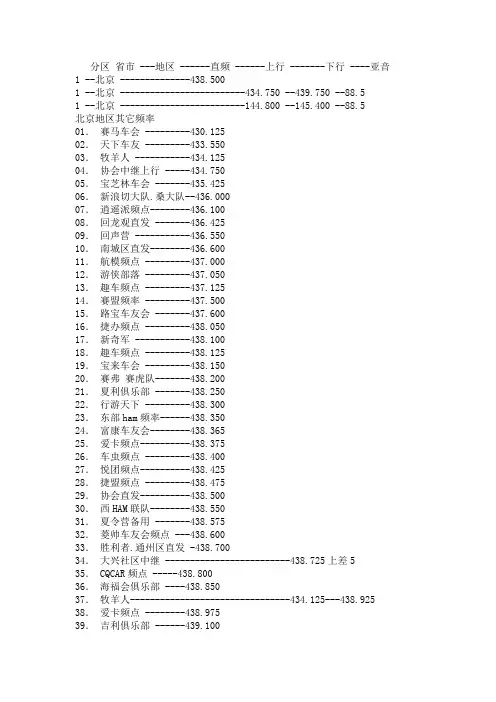
分区省市 ---地区 ------直频 ------上行 -------下行 ----亚音1 --北京 --------------438.5001 --北京 -------------------------434.750 --439.750 --88.51 --北京 -------------------------144.800 --145.400 --88.5北京地区其它频率01.赛马车会 ---------430.12502.天下车友 ---------433.55003.牧羊人 -----------434.12504.协会中继上行 -----434.75005.宝芝林车会 -------435.42506.新浪切大队.桑大队--436.00007.逍遥派频点--------436.10008.回龙观直发 -------436.42509.回声营 -----------436.55010.南城区直发--------436.60011.航模频点 ---------437.00012.游侠部落 ---------437.05013.趣车频点 ---------437.12514.赛盟频率 ---------437.50015.路宝车友会 -------437.60016.捷办频点 ---------438.05017.新奇军 -----------438.10018.趣车频点 ---------438.12519.宝来车会 ---------438.15020.赛弗赛虎队-------438.20021.夏利俱乐部 -------438.25022.行游天下 ---------438.30023.东部ham频率------438.35024.富康车友会--------438.36525.爱卡频点----------438.37526.车虫频点 ---------438.40027.悦团频点----------438.42528.捷盟频点 ---------438.47529.协会直发----------438.50030.西HAM联队--------438.55031.夏令营备用 -------438.57532.菱帅车友会频点 ---438.60033.胜利者.通州区直发 -438.70034.大兴社区中继 -------------------------438.725上差5 35. CQCAR频点 -----438.80036.海福会俱乐部 ----438.85037.牧羊人--------------------------------434.125---438.925 38.爱卡频点 --------438.97539.吉利俱乐部 ------439.10040.趣车频点 --------439.12541.北京宝来车友会 --439.17542.望京地区直发 ----439.20043.机场地区中继--------------------------439.300下差5.0544.爱车家园 -------439.35045. **QQ小学--------439.37546.密云中继------------------------------439.625 下差547.密云地区直发----439.65048.协会中继直发 ---439.75049.协会中继 -----------------------------439.750 下差5 ,88.5哑音50.开拓者俱乐部 ---439.92551. 亚运村销售联盟 ---439.65052. 高教会 ----------439.15053. 菲狐队-----------436.17554. 奥拓 ------------439.350。
